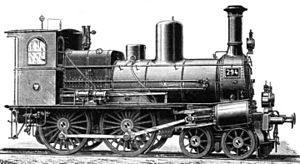Prussian P 2
In the genus P 2 of the Prussian state railways were passenger locomotives filed different type. There were 294 locomotives with the axle formula 1B, 24 with the axle formula B1 and two with the axle formula 2'B. Of the locomotives with the axle formula 1B, 88 came from the predecessor railways of the Prussian State Railways and did not correspond to the Prussian standards , 24 corresponded to the Ruhr-Sieg type (see Prussian P 1 ) and 182 to the standard design of the P 2. The locomotives with the axle formula B1 corresponded to G 2 .
P 2 (older normal design)
| P 2 (Prussia) | |
|---|---|
| Number: | 242 |
| Year of construction (s): | 1877-1885 |
| Axis formula : | 1B |
| Gauge : | 1435 mm ( standard gauge ) |
| Length over buffers: | 14,823 |
| Service mass: | 38.0 t |
| Friction mass: | 25.1 t |
| Wheel set mass : | 10.2 t |
| Top speed: | 70-90 km / h |
| Driving wheel diameter: | 1,580 mm |
| Impeller diameter front: | 980 mm |
| Cylinder diameter: | 420 mm |
| Piston stroke: | 600 mm |
| Boiler overpressure: | 10 bar |
| Grate area: | 1.73 m² |
| Evaporation heating surface: | 95.36 m² |
| Tender: | pr 3 T 10.5 |
| Water supply: | 10.5 m³ |
In the years 1877–1885, a total of 242 locomotives of the P 2 of the normal design were delivered to the Prussian State Railways and their predecessor railways. Initially, the locomotives were intended for traffic on the so-called Kanonenbahn Berlin – Wetzlar (–Metz), later they were also used on other routes in express and passenger train services. When it was redesigned in 1906, 17 of the class P 1, 182 of the class P 2 and seven of the class P 3 were assigned, the remainder had already been retired by then. The Royal Prussian Military Railway also had a P 2. Although they were very reliable, all machines were retired by the First World War .
Similar locomotives were procured for the Neustrelitz-Warnemünder Eisenbahn and the Großherzoglich Mecklenburgische Friedrich-Franz-Eisenbahn , which were classified in class V (later P 2). The Lübeck-Büchener Eisenbahn had nine P 2s in their inventory, but they were somewhat smaller and weaker than the Prussian ones.
The vehicles were equipped with a Crampton boiler, resettable guide frame, internal control according to sample sheet 15 (158 units) or external control according to sample sheet 16 (84 units). They were with a Tender equipped to type 3 T 10.5.
P 2 of the Rhenish Railway
| P 2 type Rheinische Bahn (Prussia) | |
|---|---|
|
P 2 type Rheinische Bahn
|
|
| Number: | 12 |
| Year of construction (s): | 1879, 1886 |
| Retirement: | until 1906 |
| Axis formula : | 2 B |
| Gauge : | 1435 mm ( standard gauge ) |
| Length over buffers: | 14,125 mm |
| Service mass: | 36.5 t |
| Friction mass: | 24.8 t |
| Wheel set mass : | 12.4 t |
| Driving wheel diameter: | 1,708 mm |
| Impeller diameter front: | 905 mm |
| Cylinder diameter: | 432 mm |
| Piston stroke: | 610 mm |
| Boiler overpressure: | 10 bar |
| Grate area: | 1.70 m² |
| Evaporation heating surface: | 85.7 m² |
| Tender: | pr 2 T 7 |
| Water supply: | 7 m³ |
| Fuel supply: | 3.5 tons of coal |
For traffic on the winding Cologne – Euskirchen – Trier route, the Rheinische Eisenbahn-Gesellschaft procured seven locomotives with the axle formula 2'B, which were also the first locomotives of this type in Prussia, for use in express and passenger train services . Due to the movable front bogie, the wear on the wheel flanges was not as severe as on the locomotives with a rigid axle. The first seven locomotives procured by Vulcan in 1879 were followed in 1886 by another five locomotives of the same design delivered by Hanomag to the Cologne headquarters on the left bank of the Rhine. These locomotives were later given to the Saarbrücken directorate. Two of them were given the new designation P 2 Saarbrücken in 1567 and 1568, but were retired by 1906.
literature
- Rauter, Herbert; Prussia Report Volume No. 4, Hermann-Merker-Verlag Fürstenfeldbruck 1991, ISBN 3-922404-21-9
- Wagner, Bäzold, Zschech, Lüderitz; Locomotives of Prussian Railways - express train and passenger locomotives Railway vehicle archive Volume 2.3.1, transpress Berlin 1990: ISBN 3-87094-133-2
